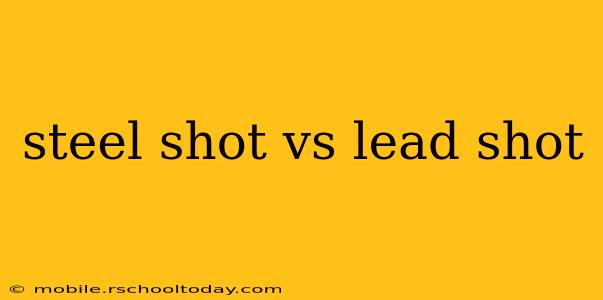For decades, lead shot reigned supreme in the world of hunting and shooting sports. However, concerns about environmental impact and toxicity have led to a significant shift towards steel shot. This comprehensive guide delves into the key differences between steel and lead shot, helping you make an informed decision based on your specific needs and preferences.
Environmental Impact: The Driving Force Behind the Shift
The most significant difference between steel and lead shot lies in their environmental impact. Lead is a highly toxic heavy metal that poses a serious threat to wildlife, particularly waterfowl. Lead shot ingested by birds can cause lead poisoning, leading to decreased reproductive success, neurological damage, and even death. This environmental concern has driven many jurisdictions to ban or restrict the use of lead shot in hunting, particularly for waterfowl. Steel shot, being non-toxic, offers a significantly more environmentally friendly alternative.
Performance Differences: A Detailed Look at Ballistics
While both steel and lead shot achieve similar results in terms of killing power at close range, there are notable performance differences to consider:
Density: The Key Factor Affecting Pattern and Penetration
Lead shot is significantly denser than steel shot. This means that for the same size, a lead pellet will have more mass and momentum. This translates to:
- Greater penetration: Lead shot generally penetrates targets more effectively, particularly through dense cover or at longer ranges.
- Tighter patterns: Lead shot tends to produce tighter patterns at longer ranges, improving accuracy.
Steel shot, being less dense, requires a larger shot size to achieve comparable penetration and pattern density to lead shot. This often means using a higher gauge shotgun or adjusting choke constrictions.
Hardness and Deformation: Impact on Target and Barrel
Steel is harder than lead. This hardness can lead to increased barrel wear in older shotguns not designed for steel shot. Modern shotguns, however, are generally compatible with steel shot. The hardness of steel also means that it's less likely to deform upon impact, potentially leading to a more consistent pattern but potentially less lethal effect on the target depending on the shot size and velocity.
Recoil: A Noticeable Difference
Due to its lower density, steel shot generally produces less recoil than lead shot of the same size. This can be a significant advantage for shooters, especially those with less experience.
Choosing the Right Shot: Considerations for Hunters and Shooters
The best choice between steel and lead shot depends heavily on your specific application:
Waterfowl Hunting: Steel is the Clear Winner
For waterfowl hunting, steel shot is the environmentally responsible and often legally mandated choice. Understanding the ballistic differences and selecting the appropriate shot size and choke are crucial for effective hunting.
Upland Game Hunting: A More Nuanced Decision
For upland game hunting, the use of steel shot is increasingly common, although lead shot may still be preferred in some situations due to its superior penetration. Always check local regulations.
Clay Target Shooting and Sporting Clays: Lead Remains Popular
In clay target shooting and sporting clays, lead shot remains the most popular choice due to its consistent performance and tighter patterns. However, steel shot options are readily available and becoming increasingly popular for their environmentally friendly properties.
Conclusion: A Responsible Choice for the Future
The shift from lead to steel shot reflects a growing awareness of environmental responsibility in the hunting and shooting sports communities. While steel shot presents some performance trade-offs, its environmental benefits are undeniable. Understanding the key differences and choosing the appropriate shot type for your specific needs will ensure both ethical and effective shooting. Always check local regulations regarding the use of lead and steel shot before heading out for your next hunting trip.
